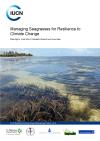There is growing evidence that seagrasses are…
There is growing evidence that seagrasses are experiencing declines globally due to anthropogenic threats (Short and Wyllie Echeverria 1996, Duarte 2002, Orth et al. 2006). Runoff of nutrients and sediments that affect water quality is the greatest anthropogenic threat to seagrass meadows, although other stressors include aquaculture, pollution, boating, construction, dredging and landfill activities, and destructive fishing practices. Natural disturbances such as storms and floods can also cause adverse effects. Potential threats from climate change include rising sea levels, changing tidal regimes, UV radiation damage, sediment hypoxia and anoxia, increases in sea temperatures and increased storm and flooding events. Thus, seagrass meadows, the ecosystems that they support and the ecosystem services that they provide are threatened by a multitude of environmental factors that are currently changing or will change in the future.
Available online
Call Number: [EL]
ISBN/ISSN: 978-2-8317-1089-1
Physical Description: 60 p. ; 29 cm
Data and Resource
| Field | Value |
|---|---|
| Publisher | International Union for Nature Conservation (IUCN) |
| Modified | |
| Release Date | |
| Source URL | https://library.sprep.org/content/managing-seagrasses-resilience-climate-change |
| Identifier | VL-35899 |
| Spatial / Geographical Coverage Location | Pacific Region |
| Relevant Countries | Pacific Region |
| License |
SPREP Public Licence
![[Open Data]](https://assets.okfn.org/images/ok_buttons/od_80x15_blue.png)
|
| Contact Name | SPREP Records and Archives Officer |
| Contact Email | [email protected] |
